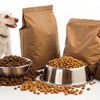How to Transition Your Dog from Kibble to Raw: A Comprehensive Guide
- Houndsy
Table of Contents
- Introduction
- Understanding the Benefits of a Raw Diet
- Factors to Consider Before Transitioning
- Methods for Transitioning to Raw
- Monitoring Your Dog’s Health
- Tips for a Successful Transition
- Conclusion
- FAQs
Introduction
Did you know that nearly 32% of dog owners prioritize health and wellness when choosing pet food? This statistic underscores a growing trend among pet parents who are seeking to provide their furry friends with the best possible nutrition. As we look at the myriad of options available, one dietary approach that has gained considerable attention is the transition from kibble to a raw food diet. But how do we make this change without causing distress to our beloved pets? This blog post will walk you through the steps of transitioning your dog from kibble to raw, highlighting the benefits, potential challenges, and practical strategies to ensure a smooth and successful change.
Switching your dog’s diet is not merely a matter of preference; it can significantly impact their health and overall well-being. A raw diet is rich in nutrients, offering fresh, natural ingredients that can lead to healthier skin, a shinier coat, improved digestion, and increased energy levels. By the end of this article, you will have a clear understanding of how to transition your dog effectively, what to expect during the process, and how to monitor their health for optimal results.
We will cover the following topics in detail:
- The benefits of a raw diet.
- Factors to consider before making the switch.
- Different methods for transitioning.
- Monitoring your dog’s health during the transition.
- Tips for success and troubleshooting common issues.
Let’s embark on this journey together and make mealtime a nourishing and enjoyable experience for our canine companions!
Understanding the Benefits of a Raw Diet
Before diving into the transition process, it’s crucial to understand why many dog owners are choosing to switch to a raw diet. The benefits can be significant and varied, including:
Improved Digestion
Raw diets are easier for dogs to digest because they are more aligned with their natural dietary needs. Dogs have evolved to consume a diet rich in protein, which is often lacking in processed kibble. A raw diet typically consists of meat, bones, and some vegetables, which can improve gut health and reduce gastrointestinal issues.
Healthier Skin and Coat
Many pet owners report noticeable improvements in their dog’s skin and coat condition after switching to raw food. The high-quality ingredients found in raw diets can lead to a shinier coat, reduced shedding, and less itching.
Increased Energy Levels
A raw diet can provide your dog with more energy. The absence of fillers and artificial additives means that your dog is receiving more nutrients per meal, which can translate into increased vitality and playfulness.
Reduced Stool Volume
Dogs on a raw diet often produce smaller, firmer stools because they are digesting more of what they eat, leaving less waste. This not only makes clean-up easier but can also indicate that your dog is absorbing nutrients effectively.
Enhanced Dental Health
Chewing raw meaty bones can help to naturally clean your dog’s teeth, reducing tartar buildup and promoting healthier gums.
Weight Management
Raw diets tend to be lower in carbohydrates than kibble, which can be beneficial for weight management. This is especially important for dogs that may be prone to obesity.
Understanding these benefits can make the prospect of transitioning to a raw diet more appealing. However, it’s essential to approach the switch thoughtfully and cautiously.
Factors to Consider Before Transitioning
Transitioning your dog from kibble to raw is not a decision to be made lightly. Several factors should be considered before making the switch:
Your Dog’s Age and Health
Puppies, adult dogs, and senior dogs may require different approaches when transitioning to a raw diet. Puppies need a balanced diet that supports their growth, while senior dogs may have specific health concerns that require careful consideration. Always consult your veterinarian before making significant dietary changes, especially if your dog has any pre-existing health conditions.
Your Dog’s Current Diet
If your dog has been on kibble for an extended period, their digestive system may need more time to adjust to raw food. A gradual transition is often more successful than a sudden switch, particularly for dogs with sensitive stomachs.
Food Preferences
Some dogs may be more receptive to raw food than others. Their previous experiences with kibble can influence how they react to new textures and flavors. Understanding your dog’s preferences can help tailor the transition process.
Commitment to Preparation
Switching to a raw diet often requires more meal preparation than feeding kibble. Pet owners must be prepared to handle raw meat safely, store it properly, and balance their dog’s diet to ensure they receive adequate nutrition.
Methods for Transitioning to Raw
There are several methods for transitioning your dog from kibble to raw, each with its pros and cons. The best approach will depend on your dog’s individual needs and your comfort level.
1. Gradual Transition
This method involves slowly introducing raw food into your dog’s diet while gradually decreasing the amount of kibble. This approach is often recommended for dogs that may be sensitive to dietary changes.
Sample Schedule for Gradual Transition:
- Days 1-3: Feed 25% raw and 75% kibble.
- Days 4-6: Feed 50% raw and 50% kibble.
- Days 7-9: Feed 75% raw and 25% kibble.
- Day 10 onwards: Feed 100% raw.
This gradual approach allows your dog’s digestive system to adjust to the new food, reducing the risk of gastrointestinal upset.
2. Cold Turkey Switch
For some confident pet owners, a cold turkey approach can be employed. This involves stopping kibble entirely and immediately feeding raw. While this method can work for some dogs, it’s not recommended for those with sensitive stomachs or those who have been on kibble for a long time.
3. Treat First Approach
In this method, you start by offering raw food as a treat while still providing kibble as the main meal. This can encourage your dog to accept raw food without feeling overwhelmed. Once they are comfortable with the raw treats, you can gradually increase the portion of raw food in their meals.
4. Separate Meals Approach
This method involves feeding raw food and kibble at separate meal times. For example, you might feed kibble in the morning and raw food in the evening. This can help prevent digestive upset by allowing your dog’s stomach to clear before they eat another type of food.
5. Cook Before Raw
If your dog is particularly sensitive, you might consider lightly cooking the food at first. Gradually reduce the cooking time until you are serving raw. This can help ease the transition for dogs that have only ever eaten cooked or processed food.
Monitoring Your Dog’s Health
As you transition your dog to a raw diet, it’s important to monitor their health closely. Here are some things to watch for:
Digestive Changes
It’s common for dogs to experience some digestive upset during the transition. You may notice changes in stool consistency or frequency. Keep an eye on these changes and consult your veterinarian if they persist beyond a few days.
Energy Levels
Observe how your dog’s energy levels change after the switch. Many owners report increased energy once their dog fully transitions to a raw diet.
Skin and Coat Condition
Monitor your dog’s skin and coat for any improvements or changes. A shiny, healthy coat is a good indicator of a successful diet.
Appetite
It may take some time for your dog to adjust to raw food. Be patient and allow them to explore their new meals. If they are consistently refusing to eat, consider mixing in a small amount of their old kibble to entice them.
Tips for a Successful Transition
To help ensure a smooth transition from kibble to raw, consider the following tips:
1. Start Slow
Starting with small amounts of raw food can help prevent digestive issues. Gradually increase the portion over time as your dog becomes more comfortable with the new diet.
2. Make it Enticing
Some dogs may be hesitant to try raw food at first. You can make their meals more appealing by mixing in a small amount of their favorite treats, such as a sprinkle of cheese or a splash of low-sodium bone broth.
3. Stay Patient
Every dog is different, and the transition process may take longer for some than others. Patience is key!
4. Consult a Veterinarian
Regular check-ins with your veterinarian can provide peace of mind and ensure that your dog is receiving a balanced diet throughout the transition. They can offer guidance tailored to your dog’s specific health needs.
5. Consider Houndsy’s Kibble Dispenser
As we navigate this transition, a product that can enhance your dog feeding experience is the Houndsy Kibble Dispenser. This innovative dispenser allows for precise portion control, ensuring your dog receives the right amount of food while making mealtime a more enjoyable experience. With a sleek design that complements modern decor, it’s the perfect addition to your pet care routine.
Conclusion
Transitioning your dog from kibble to raw can seem daunting, but with the right approach, it can be a rewarding experience for both you and your furry friend. The benefits of a raw diet are substantial, and by understanding the various methods of transitioning, monitoring your dog’s health, and remaining patient, you can set the stage for a happier, healthier pet.
As you embark on this journey, remember to celebrate the small victories along the way. Ask yourself: How does your dog seem during this change? Are they responding well to their new meals? Engaging with your dog and being attuned to their needs will enhance the transition process.
If you’re ready to take the next step in elevating your dog’s feeding experience, check out the Houndsy Kibble Dispenser today!
FAQs
How long does it take for a dog to adjust to a raw diet?
The adjustment period can vary depending on the individual dog. Some dogs may adapt within a week, while others may take several weeks. Gradually introducing raw food can help ease this transition.
Can I mix raw food with kibble during the transition?
While it’s generally best to avoid mixing raw and kibble in the same meal, you can feed them at different times to help your dog adjust. This method can reduce the risk of digestive upset.
What should I do if my dog refuses to eat raw food?
If your dog is hesitant to try raw food, try mixing a small amount of their favorite treat or kibble into the raw meal to entice them. Be patient and give them time to adjust to the new food.
Is a raw diet safe for all dogs?
While a raw diet can benefit many dogs, it may not be suitable for those with certain health issues. Always consult your veterinarian before making significant dietary changes.
How do I ensure my dog is getting a balanced raw diet?
It’s important to research and understand the nutritional requirements for your dog’s specific breed, age, and health status. Consider consulting a veterinarian or a pet nutritionist to help formulate a balanced raw diet.
By following these guidelines and keeping your dog’s needs in mind, you can successfully transition your pup to a raw diet, leading to a healthier and happier life.












